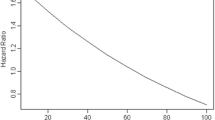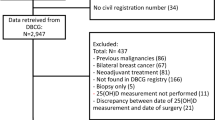Abstract
Purpose
Despite limited evidence on the association of vitamin D with outcomes in breast cancer survivors, some clinicians advise breast cancer patients to use vitamin D supplements. More evidence is needed to inform these recommendations.
Methods
In the Health, Eating, Activity, and Lifestyle study, we examined associations of post-treatment serum concentrations of 25-hydroxyvitamin D (25(OH)D) on overall and breast cancer–specific mortality in 585 breast cancer survivors from western Washington State, New Mexico, and Los Angeles County. 25(OH)D was measured in stored blood collected 2 years post-enrollment. Outcomes were ascertained from the Surveillance, Epidemiology, and End Results registries and medical records. Cox proportional hazards models were fit to assess associations of serum 25(OH)D with overall and breast cancer–specific mortality.
Results
After a median follow-up of 9.2 years; 110 women died, including 48 from breast cancer. Standard cut points classified 211 (31.6 %) women as serum 25(OH)D deficient (<20 ng/mL), 189 (32.2 %) as insufficient (20–30 ng/mL), and 185 (36.2 %) as sufficient (>30 ng/mL). Compared to women with deficient 25(OH)D, those in the sufficient ranges had a decreased risk of overall mortality (age-adjusted HR = 0.58; 95 % CI 0.36–0.96); however, multivariate adjustments attenuated the association (HR = 0.90; 95 % CI 0.50–1.61). No association was found between serum 25(OH)D and breast cancer–specific mortality (sufficient: HR = 1.21; 95 % CI 0.52–2.80) in multivariate models.
Conclusion
In this breast cancer cohort, higher serum 25(OH)D may be associated with improved survival, but results were not statistically significant and must be interpreted with caution. The potential prognostic effect of vitamin D from diet, supplements, or both should be evaluated in future larger studies with additional endpoints from breast cancer patients.


Similar content being viewed by others
References
Schwartz GG, Blot WJ (2006) Vitamin D status and cancer incidence and mortality: something new under the sun. J Nat Cancer Inst 98:428–430
Deeb KK, Trump DL, Johnson CS (2007) Vitamin D signalling pathways in cancer: potential for anticancer therapeutics. Nat Rev 7:684–700
Holick MF (2004) Vitamin D: importance in the prevention of cancers, type 1 diabetes, heart disease, and osteoporosis. Am J Clin Nutr 79:362–371
Tuohimaa P (2008) Vitamin D, aging, and cancer. Nutr Rev 66:S147–S152
Holick MF (2009) Vitamin D status: measurement, interpretation, and clinical application. Ann Epidemiol 19:73–78
Holick MF (2006) Vitamin D: its role in cancer prevention and treatment. Prog Biophys Mol Biol 92:49–59
Hewison M, Zehnder D, Chakraverty R, Adams JS (2004) Vitamin D and barrier function: a novel role for extra-renal 1 alpha-hydroxylase. Mol Cell Endocrinol 215:31–38
Palmieri C, MacGregor T, Girgis S, Vigushin D (2006) Serum 25-hydroxyvitamin D levels in early and advanced breast cancer. J Clin Pathol 59:1334–1336
Neuhouser ML, Sorensen B, Hollis BW et al (2008) Vitamin D insufficiency in a multiethnic cohort of breast cancer survivors. Am J Clin Nutr 88:133–139
Goodwin PJ, Ennis M, Pritchard KI, Koo J, Hood N (2009) Prognostic effects of 25-hydroxyvitamin D levels in early breast cancer. J Clin Oncol 27:3757–3763
Bolanowski M (2011) Commentary on an endocrine society clinical practice guidelines published in Journal of Clinical Endocrinology and Metabolism 2011;96:273–288. Endokrynologia Polska 62(Suppl 3):23–24
IoM IoM (2010) Dietary reference intakes for calcium and vitamin D. Institute of Medicine of the National Academies, Washington
Jacobs ET, Thomson CA, Flatt SW et al (2011) Vitamin D and breast cancer recurrence in the women’s healthy eating and living (WHEL) study. Am J Clin Nutr 93:108–117
Tretli S, Schwartz GG, Torjesen PA, Robsahm TE (2012) Serum levels of 25-hydroxyvitamin D and survival in Norwegian patients with cancer of breast, colon, lung, and lymphoma: a population-based study. Cancer Causes Control 23:363–370
Vrieling A, Hein R, Abbas S, Schneeweiss A, Flesch-Janys D, Chang-Claude J (2011) Serum 25-hydroxyvitamin D and postmenopausal breast cancer survival: a prospective patient cohort study. Breast Cancer Res 13:R74
McTiernan A, Rajan KB, Tworoger SS et al (2003) Adiposity and sex hormones in postmenopausal breast cancer survivors. J Clin Oncol 21:1961–1966
Rojas-Rivera J, De La Piedra C, Ramos A, Ortiz A, Egido J (2010) The expanding spectrum of biological actions of vitamin D. Nephrol Dial Transplant 25:2850–2865
Dusso AS, Brown AJ, Slatopolsky E (2005) Vitamin D. Am J Physiol Renal Physiol 289:F8–F28
Heaney RP (2000) Vitamin D: how much do we need, and how much is too much? Osteoporos Int 11:553–555
World Health Organization. International Classification of Diseases. http://www.who.int/classifications/icd/en/. Accessed 3 March 2011
Ng K, Wolpin BM, Meyerhardt JA et al (2009) Prospective study of predictors of vitamin D status and survival in patients with colorectal cancer. Br Cancer 101:916–923
Kiebzak GM, Leamy LJ, Pierson LM, Nord RH, Zhang ZY (2000) Measurement precision of body composition variables using the lunar DPX-L densitometer. J Clin Densitom 3:35–41
Holick MF (2007) Vitamin D deficiency. N Engl J Med 357:266–281
Therneau TM, Grambsch PM (2000) Modeling survival data: extending the Cox model. Springer, New York
Kleinbaum DG, Klein M (2005) Evaluating the proportional hazards assumption. Survival analysis a self-learning text, 2nd edn. Springer, New York, pp 131–171
Harrell FE Jr, Lee KL, Mark DB (1996) Multivariable prognostic models: issues in developing models, evaluating assumptions and adequacy, and measuring and reducing errors. Stat Med 15:361–387
WHO (2000) Obesity: preventing and managing the global epidemic. World Health Organization, Geneva
Wener MH, Daum PR, McQuillan GM (2000) The influence of age, sex, and race on the upper reference limit of serum C-reactive protein concentration. J Rheumatol 27:2351–2359
Bodnar LM, Catov JM, Wisner KL, Klebanoff MA (2009) Racial and seasonal differences in 25-hydroxyvitamin D detected in maternal sera frozen for over 40 years. Br J Nutr 101:278–284
Feldman D, Pike JW, Glorieux FH (2005) Vitamin D, 2nd edn. Elsevier Academic Press, Burlington
Brown AJ, Dusso A, Slatopolsky E (1999) Vitamin D. Am J Physiol 277:F157–F175
Honda H, Qureshi AR, Axelsson J et al (2007) Obese sarcopenia in patients with end-stage renal disease is associated with inflammation and increased mortality. Am J Clin Nutr 86:633–638
Mathiasen IS, Lademann U, Jaattela M (1999) Apoptosis induced by vitamin D compounds in breast cancer cells is inhibited by Bcl-2 but does not involve known caspases or p53. Cancer Res 59:4848–4856
Eisman JA, Barkla DH, Tutton PJ (1987) Suppression of in vivo growth of human cancer solid tumor xenografts by 1,25-dihydroxyvitamin D3. Cancer Res 47:21–25
Ooi LL, Zhou H, Kalak R et al (2010) Vitamin D deficiency promotes human breast cancer growth in a murine model of bone metastasis. Cancer Res 70:1835–1844
Ooi LL, Zheng Y, Zhou H et al (2010) Vitamin D deficiency promotes growth of MCF-7 human breast cancer in a rodent model of osteosclerotic bone metastasis. Bone 47:795–803
Ostrovnaya I, Olshen AB, Seshan VE, Orlow I, Albertson DG, Begg CB (2010) A metastasis or a second independent cancer? Evaluating the clonal origin of tumors using array copy number data. Stat Med 29:1608–1621
Holick MF, Garabedian M (2006) Vitamin D: photobiology, metabolism, mechanism of action, and clinical applications. In: Favus MJ (ed) Primer on the metabolic bone diseases and disorders of mineral metabolism. American Society for Bone and Mineral Research, Washington, pp 129–137
IoM IoM (1997) Dietary reference intakes: calcium, phosphorus, magnesium, vitamin D, fluoride. National Academy Press, Washington
Alpert PT, Shaikh U (2007) The effects of vitamin D deficiency and insufficiency on the endocrine and paracrine systems. Biol Res Nurs 9:117–129
Bischoff-Ferrari HA, Giovannucci E, Willett WC, Dietrich T, Dawson-Hughes B (2006) Estimation of optimal serum concentrations of 25-hydroxyvitamin D for multiple health outcomes. Am J Clin Nutr 84:18–28
Institute of Medicine (2010) Dietary reference intakes for calcium and vitamin D. The National Academies Press, Washington
Holick MF, Binkley NC, Bischoff-Ferrari HA et al (2011) Evaluation, treatment, and prevention of vitamin D deficiency: an endocrine society clinical practice guideline. J Clin Endocrinol Metab 96:1911–1930
Acknowledgments
The authors would like to thank the HEAL participants for their ongoing dedication to this study. This study was supported through National Cancer Institute contracts NO1-CN-75036-20, NO1-CN-05228, NO1-PC-67010, U54-CA116847 and training grant R25-CA094880. A portion of this work was conducted through support by the National Institutes of Health grant MO1-RR-0037, and University of New Mexico grant, NCRR MO1-RR-0997. Data collection for the Women’s CARE Study at the University of Southern California was supported by contract N01-HD-3-3175 from the National Institute of Child Health and Human Development and patient identification was supported in part by contract 050Q-8709-S1528 from the California Department of Health Services.
Conflict of interest
No potential conflicts of interest were disclosed.
Author information
Authors and Affiliations
Corresponding author
Rights and permissions
About this article
Cite this article
Villaseñor, A., Ballard-Barbash, R., Ambs, A. et al. Associations of serum 25-hydroxyvitamin D with overall and breast cancer–specific mortality in a multiethnic cohort of breast cancer survivors. Cancer Causes Control 24, 759–767 (2013). https://doi.org/10.1007/s10552-013-0158-4
Received:
Accepted:
Published:
Issue Date:
DOI: https://doi.org/10.1007/s10552-013-0158-4




